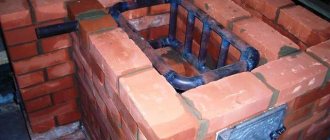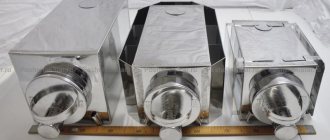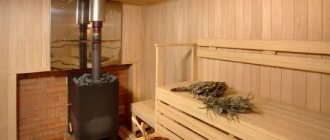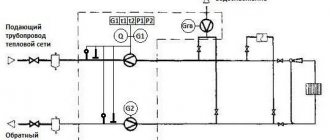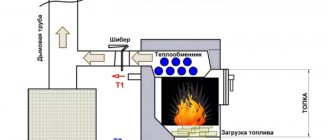The Russian bath has always been a special ritual, and visiting it has long ago become a centuries-old tradition. The bathhouse relaxes, heals, calms, and brings peace. Many owners want to install a bathhouse on their property, but the heating issue can be difficult to resolve. An obligatory element of the bathhouse has always been a stove. Its main purpose is to heat the air in the steam room to a certain temperature and at the same time heat the water for bathing. The best option is considered to be a stone stove, which not only copes excellently with the heating function, but is also a mandatory attribute of the Russian steam room. But a stone stove is not a cheap pleasure and it takes up a lot of space, but now you can buy ready-made metal stoves. But, if such stoves are suitable for bath procedures, then they are unlikely to maintain a constant temperature in the autumn-winter period: they can be included in the heating system, but they need to be heated constantly, so no periodic visits, but only constant presence.
Bath heating system: brief description, main advantages and disadvantages
Constant heating of the bath can be organized in several ways:
- Connecting to centralized heating is not the cheapest, but the easiest option.
- Liquid or solid fuel boiler. The disadvantages are the same as those of a sauna stove: constant addition of fuel is required.
- Using electricity is quite simple if it is possible to provide a separate, and what is important - guaranteed, 220/380V input (depending on the power of the heating boiler). But, firstly, you will need a whole package of documentation, which means money and time, and secondly, in rural areas there are often blackouts, and if your bathhouse is located in a summer cottage, then blackouts may be the rule and not the exception. A power outage for several days in winter can cause the system to freeze. Heating using electricity also includes electric heated floors. The pleasure is not cheap, but comfortable. And you don’t have to cook batteries or registers; power outages do not have such fatal consequences: there is no water and nothing can go bad.
The heating arrangement in the bathhouse may look like this - Gas boiler or convector. If your site has such a luxury as natural gas, then why not use it to heat your bathhouse? Of course, you need permits and a design, and gas boilers are not cheap, but the result is worth it.
- Use a pellet boiler. These systems are becoming increasingly popular. Firstly, due to the automated heating process. Pellets (from one bucket to several tons) are loaded into the bunker, and from there they are automatically fed into the boiler. You can check such a heating system once a month, or even less often: the fuel has a low ash content, and the bunker for storing it can be very large. Secondly, the installation of such a boiler does not require approvals, although the presence of electricity for ignition is required. But not everything is so rosy - pellet boilers have a high price.
- If there is a heated house on the site, an option is to extend the heating main from the house to the bathhouse and heat it that way.
Heating in the bathhouse. We all want warmth
Gas heating of the bath
A water sauna boiler is quite expensive, but the built-in heating circuit does not particularly affect the operation of the steam room, and is used in the sauna mainly in the cold season. From this point of view, the purchase and installation of a heating system for a bathhouse looks economically unjustified, especially in a situation where the bathhouse has only a steam room and a dressing room.
In addition to the boiler method of heating water, the steam room most often has a second source of boiling water - a mounted or hanging tank in which the liquid is heated to spray the heater backfill. Typically, 50 to 100 liters of water are boiled in such a tank. Is it possible to heat a bathhouse from a tank?
A simple calculation shows that in a tank with a capacity of 100 liters, filled to the top with boiling water, the heat stored is the equivalent of 8-10 MJ or 2.5-3 kW/h. If you use at least 80% of the energy, then this will be enough to organize heating of the dressing room from a sauna stove.
The sauna heating system can be improved almost twice if, instead of a built-in heating tank, you use a system with a heat exchanger built into the stove. You can extract heat from the stove in a variety of ways:
- Install a system of tubular registers made of steel pipes in a brick stove;
- Install a coil made of copper or alloy steel into the firebox;
- Use a structure made of double tanks as the walls of the combustion chamber.
We suggest you familiarize yourself with How to make a ceiling in a bathhouse from timber
To ensure efficient heating of the bath, the size of the furnace combustion chamber will need to be selected based on increased productivity. Typically, a firebox for a stove with a water circuit is selected for a single load of at least 2.5 kg of firewood.
A relatively new method of heating living rooms in private homes using heat accumulators is also gaining popularity for heating baths. Moreover, a huge tank with an alkali solution or molten paraffin is most often installed either in the basement of a building or in a nearby outbuilding. A bathhouse is best suited for these purposes.
The heat accumulator is heated either by excess heat in the furnace or solar collector, or by electric heating at night. In this case, thanks to the reduced electricity tariff, heating costs are reduced several times, especially. if the bathhouse is located next to the house. An even higher level of savings can be obtained if you solve the problem of how to install heating into a bathhouse from home.
If it is possible to connect to the gas supply system, this type of heating will provide effective heating (more details: “Advantages of a gas sauna stove and its modifications”).
Advantages of gas heating:
- environmental Safety;
- use of equipment that is easy to operate and maintain;
- cheap heating method.
Gas boilers for heating baths, even in winter, in case of prolonged non-use, can heat the room to the desired temperature within several hours, depending on the area of the room.
Bath heating with gas boilers
If gas is supplied to the site, then, naturally, gas heating of the bathhouse is the best option and installing a gas boiler will pay off: they work flawlessly, heat rooms that are quite large in size, and gas does not cost much in our country. There is no soot, soot, or heavy odor. You can do it yourself to heat a sauna using gas, but you must have a project and carefully monitor its implementation. In general, gas heating is an economical and profitable option for the owner, but gas lines in a country house or village are the exception to the rule rather than the rule, so you have to think about how to heat a bathhouse without gas.
Heating a bathhouse in winter. Which method to choose
Two houses, one energy source. How did we decide to make heating in such a situation?
Today we will talk about how you can heat a residential building using a heating main. Let's look at the topic using this example of two buildings. One main thing is a house of 340 square meters, where main natural gas is already supplied. The customer was lucky; he had no problems with this and did not need to install a gas tank. Therefore, he already had a 35-kilowatt floor-standing boiler installed. And the main task was to create a heating system in a house of 340 square meters. But he also has another house of 150 square meters, where it will no longer be possible to supply natural gas. And then the task was to create a heating system in that 150-square-meter house. Now we will tell you how this can be done using a heating main. Let's start with the first boiler room, which is located in a house of 340 square meters.
Electric heating
There are several options: you can install an electric boiler, since electricity is available almost everywhere. If we talk from a safety point of view, an electric boiler for heating a bathhouse is the safest option (subject to compliance with the rules and regulations). But the downside is that electricity costs a lot today, so you will have to pay large electricity bills. Another difficulty is that you will have to provide a separate input to connect the boiler, and often not 220V, but 380V is required, and these are completely different requirements and tariffs.
Electric boilers for water heating baths
If you use modern models of electric water heating units, then the bills may not be very large: they are controlled automatically, which maintains the set temperature in the room. You can set the temperature to +50C while you are not visiting the bathhouse. And the system will not freeze, and the bill will be small (provided that your building is well insulated). Moreover, to heat the bath, you can use stepped heating element boilers, induction and electrode (ion). They are not ideal, but according to experience, they are economical: bills come in 20-30% less.
Bath heating with convectors
If possible, it is most convenient to use electric convectors. Such a heating system in a bathhouse, of course, will be expensive. The equipment is not cheap, and electricity bills will also be hefty. But what is good about modern convectors: it is possible to set a certain thermal regime, which is maintained automatically. Many bathhouse owners do the following: while using the bathhouse, they heat the heater, and then set the anti-defrosting mode of the convector, which maintains the room temperature within +1 - +30C. Thus, the bathhouse premises do not freeze or become damp, and heating the bathhouse in winter will not cost a lot of money.
Heating in the bathhouse using convectors. Simple, but expensive and not always reliable
Electric heated floors
A very comfortable, but expensive type of heating. This applies to both the arrangement and the bills that will arrive. But if the bathhouse is insulated correctly and carefully, then maintaining the minimum temperature may not be so burdensome.
One more point: the system is installed at the stage of construction or major renovation, which is also not very convenient. Modern electric heated floors are no longer just cords that were laid out on the surface, and if damaged, part of the floor turned out to be unheated. There are roll materials with parallel thermal tracks. If one or more fail, the performance of the others remains unchanged, and the floor is still as warm.
Warm floors in the bathhouse can be made electric or water
Heating system
This option for heating a bathhouse is one of the modern methods, which has been used frequently in recent years. It is quite difficult to install special equipment without the appropriate experience.
The base of the floor is first prepared, then the screed is poured using cement mortar. Next, they waterproof the rough base using a special mastic. Then a thin layer of mortar is laid and carefully leveled.
When the mixture is completely dry, install the heat-insulating material. Take a heating cable or mat and spread it over the floor surface, connect it to power and test the functioning of the system.
In most cases, continuous burning stoves are installed in bathhouses, which do an excellent job as the main source of heat in the room. At the same time, it is worth immediately making a reservation that for arranging the stove it is advisable to use only cleaned stones, the diameter of which reaches 10 centimeters. To achieve the optimal temperature in the room, it takes at least two hours to heat such a stove, during which you will have to periodically add firewood.
The bathhouse is a wooden building with a high level of humidity in the premises. As you know, wood that is regularly exposed to water can become unusable in a very short time. Because of this, unpleasant odors may appear in the bathhouse, and the building itself will require repairs in the future.
To avoid this, issues related to its quality heating should be resolved in advance. At the same time, it is advisable not to limit yourself to just one stove, but to supplement it with various heating systems, which, moreover, will significantly reduce the time it takes to warm up the premises before taking water procedures.
For safety reasons, in a wet room such as a bathhouse, it is allowed to use one or two heating radiators, which must be connected to the heating system of a residential building. In addition, there are several other options for heating a bath, the choice of which depends only on your requirements and wishes.
We invite you to familiarize yourself with the Construction Standards for a summer cottage in 2020
Heating radiators in the bathhouse
Solid fuel boilers
A special place is occupied by combined boilers using liquid or solid fuel. The option is economical, but not entirely profitable. The price of liquid fuel is constantly increasing, so installing heating in a bathhouse that works on this principle is not entirely profitable. It is more economical to use firewood or coal. But in this case, you need to understand that they will have to be delivered frequently, and the area with the bathhouse must be available at any time of the year. And still the same drawback: “autonomously” such boilers only work for a few hours. For heating baths located in suburban areas, this is not a solution.
Solid fuel boilers. Possible, but not ideal
Today, a combined bath heating system is becoming more and more common. For this purpose, multi-fuel boilers are used. In the absence of any type of fuel, it simply switches to electricity. But these boilers are only suitable for water heating, and it is difficult to install. But having set a goal, almost every person with minimal experience will be able to create a heating system in a bathhouse with their own hands and set it up uninterrupted.
Main selection criteria
The stove must be powerful to heat the air in remote rooms to the required temperature. It is better to choose universal models. The heating stove-stove is simple, affordable, and runs on any fuel. For bath structures, the problem remained in the huge overall dimensions. The combustion process is not controlled or automated. There are always combustion products.
When heating at the same time, the location of the furnace plays a big role. The firebox, in which fuel is loaded and ash and coals are removed, is located in the accessible part of the dressing room. The other part goes into the greenhouse, the washing compartment. Maximum heating necessarily occurs in the greenhouse portion. The temperature of this part is higher than all other places. The location of the water supply depends on the design of the bathhouse. The heated water disperses throughout the bathhouse and goes into other rooms to warm the walls and air.
The following can be used as an energy source:
- wood;
- solid fuel;
- gaseous fuel;
- electricity.
note.
The most environmentally friendly fuel is firewood. It is expensive to burn with wood alone; it is combined with coal.
Purchase, installation, installation of electrical equipment is more expensive. During operation, it does not form combustion products, takes up less space, and is controllable.
We combine the heating of the dacha with the heating of the bathhouse
Twenty or thirty years ago, it never occurred to anyone that it was possible to create heating for a bathhouse from home. It was always believed: a bathhouse, there is a bathhouse, a house, there is a house, and they will not be connected together. However, modern technologies, the desire of owners to save money, and some other needs make it possible to think about how to install heating from a house to a bathhouse.
Any boiler requires a separate room, which must comply with all safety regulations and standards. In fact, without creating and approving a project in the relevant authorities, nothing will happen. All this requires both time and significant financial costs.
We connect the house and the bathhouse with a heating main
A heating main laid by yourself will be cheaper. Many amateur bath attendants do this. But even in this situation, there are certain rules and small tricks, knowing which a non-professional will avoid many problems in the future:
- When designing a heating main, take into account the location of groundwater: pipes should not be in water.
- The pipeline must be insulated, and a larger diameter pipe is put on top (corrugation can be used). Then it will be protected from groundwater, and heat loss will be small.
In general, the efficiency of such a bathhouse heating system will depend on the distance at which the bathhouse is located from the house. If the distance is short, then this option may be the best. But if the distance is significant, then it may turn out that by the time the water reaches the bathhouse, it will have cooled down so much that it will not be able to somehow influence its temperature.
Furnace materials
The materials chosen for heating are:
- brick;
- cast iron;
- metal.
Brick construction is the simplest option. A brick lining is used, with a chimney and firebox laid. Outdated for domestic buildings. Combustion requires a lot of wood and coal, which is not profitable. Construction requires a professional craftsman; errors affect heating and the safety of residents. To supply hot water, it is wise to use double-circuit wiring. The stove can be upgraded by installing a metal hob on it.
note.
Cast iron is more valuable for the production of stoves. It has good heat transfer and takes a long time to cool down.
Many design options allow you to choose not only in size, but also in design. They have powerful heat output. Suitable fuels include firewood, coal, peat, and diesel fuel.
Metal stoves are more common and cost-effective. Parts of the structure are cut out of metal. Another name is Finnish. The metal heats up evenly and retains heat for a long time. Air channels are created to warm the air. A cold flow enters the lower part, and a hot flow comes out at the upper part. Characterized by their efficiency. It is advisable to use natural wood for combustion.
Pellet boilers
This type of heating is used in almost 50% of European homes, and they can count. This popularity is based on the possibility of automatic fuel supply. Fuel is loaded into the bunker (it can be of any size from an ordinary box to a large room), which is supplied to the burner using a screw controlled by the boiler. In this mode, the system operates as long as there is fuel and the ash pan is not full. If the fuel is of high quality, the ash needs to be removed once every month and a half, and the pellet bunker, as mentioned, can be of any volume. The only thing: to ignite and maintain the operation of the equipment, guaranteed power is required (the consumption is very small). But modern heating systems, it seems, cannot work without electricity. Here, too, if you wish, you can find a solution - diesel engines, batteries, etc. Pellets are not that expensive; the only significant drawback is the cost of the boiler itself. Not everyone will decide to invest this amount in heating a bathhouse.
Pellet boilers are reliable and promising, but the equipment is expensive
As you can see, there are many ways to heat a bathhouse, but all of them are imperfect. You will have to weigh the pros and cons more than once and calculate the options.

